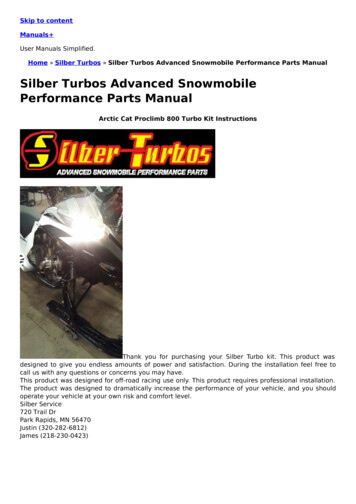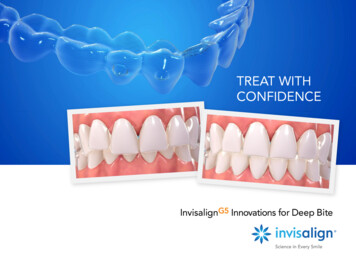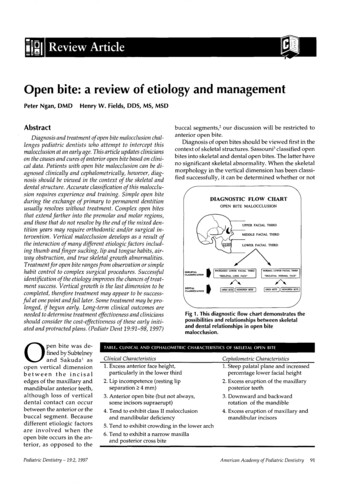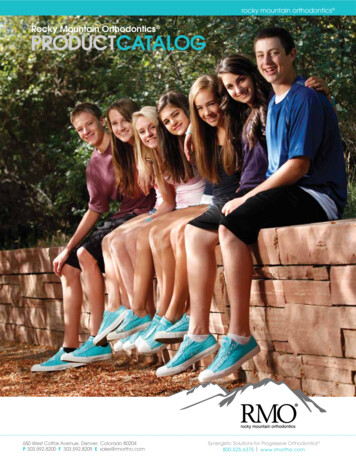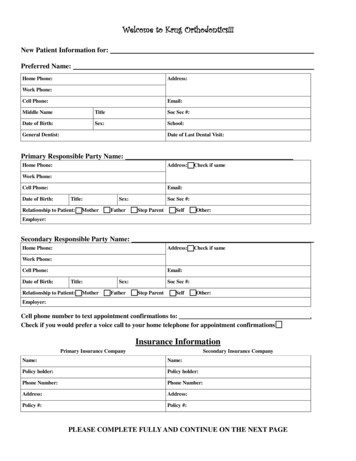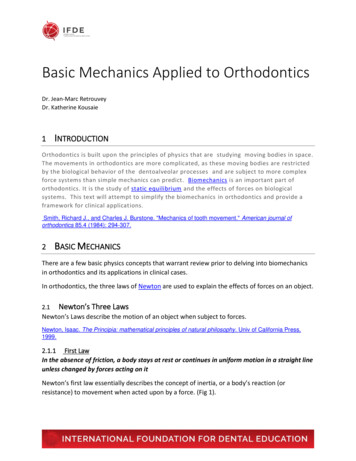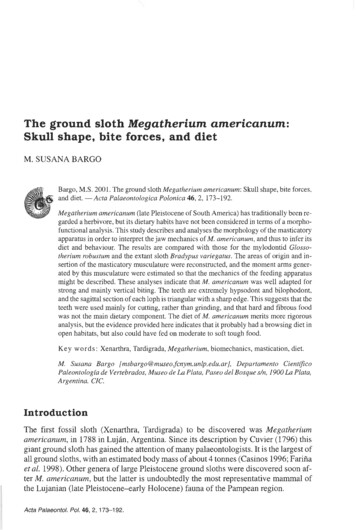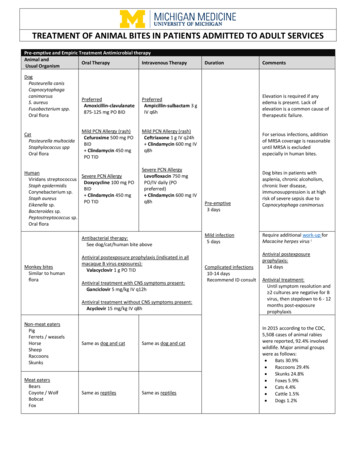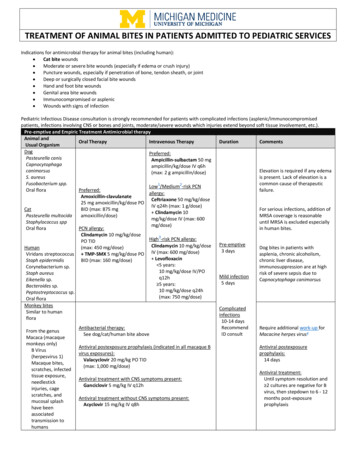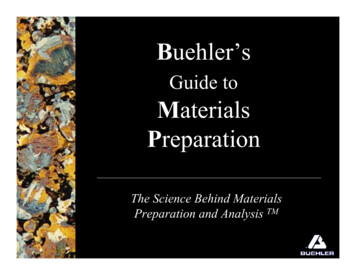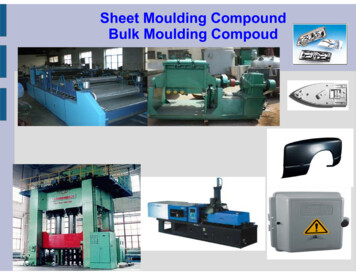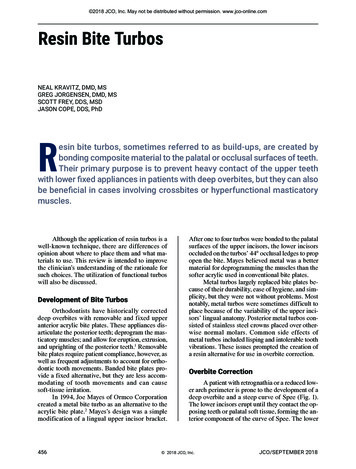
Transcription
2018 JCO, Inc. May not be distributed without permission. www.jco-online.comResin Bite TurbosNEAL KRAVITZ, DMD, MSGREG JORGENSEN, DMD, MSSCOTT FREY, DDS, MSDJASON COPE, DDS, PhDResin bite turbos, sometimes referred to as build-ups, are created bybonding composite material to the palatal or occlusal surfaces of teeth.Their primary purpose is to prevent heavy contact of the upper teethwith lower fixed appliances in patients with deep overbites, but they can alsobe beneficial in cases involving crossbites or hyperfunctional masticatorymuscles.Although the application of resin turbos is awell-known technique, there are differences ofopinion about where to place them and what materials to use. This review is intended to improvethe clinician’s understanding of the rationale forsuch choices. The utilization of functional turboswill also be discussed.Development of Bite TurbosOrthodontists have historically correcteddeep overbites with removable and fixed upperanterior acrylic bite plates. These appliances disarticulate the posterior teeth; deprogram the masticatory muscles; and allow for eruption, extrusion,and uprighting of the posterior teeth.1 Removablebite plates require patient compliance, however, aswell as frequent adjustments to account for orthodontic tooth movements. Banded bite plates provide a fixed alternative, but they are less accommodating of tooth movements and can causesoft-tissue irritation.In 1994, Joe Mayes of Ormco Corporationcreated a metal bite turbo as an alternative to theacrylic bite plate.2 Mayes’s design was a simplemodification of a lingual upper incisor bracket.456After one to four turbos were bonded to the palatalsurfaces of the upper incisors, the lower incisorsoccluded on the turbos’ 44 occlusal ledges to propopen the bite. Mayes believed metal was a bettermaterial for deprogramming the muscles than thesofter acrylic used in conventional bite plates.Metal turbos largely replaced bite plates because of their durability, ease of hygiene, and simplicity, but they were not without problems. Mostnotably, metal turbos were sometimes difficult toplace because of the variability of the upper incisors’ lingual anatomy. Posterior metal turbos consisted of stainless steel crowns placed over otherwise normal molars. Common side effects ofmetal turbos included lisping and intolerable toothvibrations. These issues prompted the creation ofa resin alternative for use in overbite correction.Overbite CorrectionA patient with retrognathia or a reduced lower arch perimeter is prone to the development of adeep overbite and a steep curve of Spee (Fig. 1).The lower incisors erupt until they contact the opposing teeth or palatal soft tissue, forming the anterior component of the curve of Spee. The lower 2018 JCO, Inc.JCO/september 2018
Dr. KravitzDr. JorgensenDr. FreyDr. CopeDr. Kravitz is an Associate Editor of the Journal of Clinical Orthodontics and in the private practice of orthodontics at 25055 Riding Plaza, Suite 110,South Riding, VA; e-mail: nealkravitz@gmail.com. Dr. Jorgensen is in the private practice of orthodontics in Rio Rancho, NM. Dr. Frey is in the privatepractice of orthodontics in Chesapeake, VA. Dr. Cope is an Adjunct Assistant Professor, Department of Orthodontics, College of Dentistry, TexasA&M University, Dallas, and in the private practice of orthodontics in Dallas.patients, the lower second molars should be bonded as early as possible. Light, vertical posteriorelastics (2oz) can be prescribed to assist in premolar extrusion. In a patient with hyperfunctionalmasticatory muscles, as is commonly seen inlow-angle cases, Botox* can be used in conjunctionwith bite turbos to facilitate posterior extrusion.3The posterior teeth are discluded by the resin turbos on the upper central incisors.Turbo LocationsFig. 1 Steep curve of Spee commonly seen in retrognathic, low-angle patients. Lower second molarserupt distal to upper first molars and prior to uppersecond molars, causing supraeruption. Bonding lowersecond molars is critical because they assist in extruding premolars and first molars for overbite correction.second molars then erupt distal to the upper firstmolars and are unopposed until they contact theupper second molars, making up the posteriorcomponent.Overbite correction requires a reversal of thisprocess to level the curve of Spee. Specifically, thepremolars and first molars are extruded, while theincisors, canines, and second molars are intruded.Complete leveling of the curve of Spee is difficultwithout bonding the lower second molars, becausetheir inclusion provides a lever arm for extrusionof the lower posterior teeth.1Because posterior extrusion and overbite correction can be particularly challenging in low-angleVOLUME LII NUMBER 9The mandibular plane angle is always an important factor in choosing turbo locations. Anterior resin turbos are indicated in low-angle patients,while posterior resin turbos are better suited foraverage-angle cases.1 Anterior turbos should beused with caution in high-angle cases because ofthe risk of undesirable posterior extrusion; instead,only the upper teeth should be bracketed until theoverbite has been reduced enough for the lowerteeth to be bonded.The most common locations for anteriorresin turbos are on the lingual aspect of the uppercentral incisors (Fig. 2). Both central incisors arecustomarily bonded to broadly distribute the occlusal forces. Upper lateral incisors are rarelyused because of their shorter roots, although thiscould be an alternative location if the patient develops a lisp.Posterior resin turbos are usually placed onthe supporting cusps of the lower first molars (Fig.*Registered trademark of Allergan USA, Madison, NJ; www.botox.com.457
RESIN BITE TURBOS3). In a preadolescent patient, the lower second deciduous molars are another possibility. Some practitioners prefer placing turbos on the upper premolars and first molars for easier isolation duringbonding. On the whole, however, posterior turbosare less effective in providing clearance for loweranterior brackets and may require excessive thickness in low-angle patients.Each has advantages and disadvantages related toits color, placement and removal techniques, andglass filler content (Table 1).Glass fillers such as quartz and silica are included in dental resins primarily to add hardness;they also help minimize polymerization shrinkageand improve handling characteristics. In orthodontic resins, fillers reduce the incidence of bracketdebonding due to cohesive failure and of materialwashout under bands, and they add body to controlbracket flotation. On the other hand, the use of aturbo material with high filler content increasesthe risk of abrasion on opposing teeth. Quartz isof particular concern because it is harder and moreMaterial ChoicesMany materials have been proposed for resin turbos, including acrylic gels, band cements,bracket adhesives, and lingual retainer adhesives.aFig. 2 A. Upper anterior turbos on both central incisors. B. Dome-shaped turbos covering most of cingulaeimprove tolerance and apply intrusive forces to upper andlower incisors.abbFig. 3 A. Lower posterior turbos on first molars. B. Tube-shaped lower first-molar turbos placed along supportingcusps. Archwire helps apply intrusive forces to lower second molars and extrusive forces to premolars and firstmolars. Resin can be extended over bracket pad for added bracket retention.458JCO/september 2018
KRAVITZ, JORGENSEN, FREY, COPETABLE 1POPULAR MATERIAL CHOICESProductOriginal PurposesTypeAdvantagesDisadvantagesTriad Gel**Bite plates, castmodificationAcrylic gelSoft, light colorPolymerizationshrinkage, hyperemiaUltra Band-Lok***Band cementCompomer pasteBonds to metal,distinct colorCasts a blue shadeTruLock Light CureBand Adhesive†Band cementCompomer pasteBonds to metal,Casts a blue shadedistinct color, fluoridereleasingKetac‡Band cement,permanentrestorationsGlass ionomercementMoisture insensitive,fluoride releasingDifficult to removeBlugloo, Grengloo††Bracket adhesiveResin pasteColor changePotential for wearTransbond LR‡Lingual retaineradhesiveResin pasteBond strengthPotential for wearFlow Tain‡‡Lingual retaineradhesiveFlowable resinEasy applicationPotential for wearTwinky Star§Pediatric restorations Compomer pasteEasy application,distinct colorPotential for wearabrasive than silica. Acrylic gels and band cements,which have lower quartz contents, are thereforemost commonly used to make resin turbos.Triad Gel** is an acrylic resin liquid designed for fabricating bite plates and modifyingdental casts (Fig. 4). Its composition is primarilyFig. 4 Tube of Triad Gel** and push syringe of UltraBand-Lok.***VOLUME LII NUMBER 9methacrylate mixed with silica glass (1-10% byweight). Because its formula is similar to that ofan acrylic bite plate, it carries little risk of toothabrasion. The small tubes of resin are available infour colors: clear colorless, clear pink, clear blue,and clear red. These light colors are acceptable topatients but visible enough to aid placement andremoval by the orthodontist. After the teeth areetched and primed, Triad Gel can be applied witha microbrush or a repurposed adhesive syringe**Registered trademark of Dentsply Sirona, York, PA; www.dentsplysirona.com.***Registered trademark of Reliance Orthodontics, Inc., Itasca, IL;www.relianceorthodontics.com.†Registered trademark of Rocky Mountain Orthodontics, Denver,CO; www.rmortho.com.‡Trademark of 3M Unitek, Monrovia, CA; www.3Munitek.com.††Trademark of Ormco Corporation, Orange, CA; www.ormco.com.‡‡Trademark of Reliance Orthodontics, Inc., Itasca, IL; www.relianceorthodontics.com.§VOCO America, Inc., Indian Land, SC; www.voco.com/us.459
RESIN BITE TURBOSFig. 5 A. Application of Triad Gel using repurposed opaque syringe with18-gauge Luer lock tip. B. Application of Ultra Band-Lok with microbrush.abaFig. 6 A. Functional turbo bonded to lower incisorsfor correction of mild anterior crossbite. B. Turbobeveled lingually for proper contact with upper incisor.(Fig. 5). One disadvantage is that the exothermicreaction created by light curing can cause hyperemia and discomfort. This is often observed whenturbos are placed on the upper incisors. The resinalso undergoes substantial polymerization shrinkage, so the clinician should verify the marginalseal to avoid decalcification under the turbos.Ultra Band-Lok*** is a compomer paste—ahybrid of dental resin and glass ionomer—used forsecuring orthodontic bands and large acrylic appliances (Fig. 4). Its composition includes a glassfiller (50-75% by weight), methacrylate, and acidmonomer. The product is packaged in a push syringe; after the teeth are etched and primed, it canbe applied with a microbrush or directly from thesyringe tip (Fig. 5). Ultra Band-Lok has the handling properties of dental resin and the bondingadvantages of glass ionomer. Its acid monomerallows it to bond chemically to metal alloys, which460bis particularly beneficial for turbos placed on lower first molars with buccal or occlusal amalgamrestorations. Ultra Band-Lok’s bright blue colorfacilitates placement and removal, but can also casta dark shade through thin upper incisors. Mostimportant, because the glass filler contains somequartz, the opposing teeth should be checked periodically for abrasion, particularly if the materialis used to construct functional turbos.Functional TurbosBeveled resin turbos, also referred to as functional turbos, are constructed with beveled occluding surfaces that guide the opposing teeth towardthe desired positions. Their most common application is in the correction of a mild anterior crossbite (Fig. 6). Resin turbo material is bonded to theincisal edges of two or more lower incisors andJCO/september 2018
KRAVITZ, JORGENSEN, FREY, COPEaFig. 7 A. Functional turbos on first premolars.B. Turbos promote disarticulation to help correctClass II malocclusion.bsame technique can be applied in Invisalign§§§patients by adding unfilled rectangular attachmentsto the occlusal surfaces of the aligners (Fig. 8).ConclusionFig. 8 Invisalign§§§ functional turbos created withunfilled occlusal attachments (yellow) on first premolars.then beveled lingually. Upon contacting the beveled surface, the upper incisors are nudged forwardand the lower jaw is directed posteriorly.4 The dental crossbite will usually be corrected in aboutthree months.Functional turbos can also be placed on premolars to improve disarticulation in Class II patients (Fig. 7). These turbos essentially operate likea bonded Twin Block§§ appliance: the mandible isdisarticulated and repositioned as the occludingpremolars slide along the beveled surfaces. TheVOLUME LII NUMBER 9Resin bite turbos are usually placed on theupper central incisors or the lower first molars,depending on the mandibular plane angle. Although we have suggested using an acrylic gel orband cement, many other materials are acceptableas long as the quartz filler content is low enoughor the duration of use is short enough to avoid occlusal wear on the opposing teeth.REFERENCES1. McLaughlin, R.P.; Bennett, J.C.; and Trevisi, H.J.: SystemizedOrthodontic Treatment Mechanics, Mosby, St. Louis, 2001.2. Mayes, J.H.: Bite turbos: New levels of bite-opening acceleration, Clin. Impress. 6:15-17, 1997.3. Frey, S.: The case for soft-tissue orthodontics, Dentaltown, 4248, published online, December 2015.4. Jain, U.; Bharti, C.; and Chhajed, R.: A simplified method ofcorrecting single-tooth crossbite, J. Clin. Orthod. 50:437-438,2016.***Registered trademark of Reliance Orthodontics, Inc., Itasca, IL;www.relianceorthodontics.com.§§Trademark of Protec Dental Laboratories Ltd., Vancouver, BC,Canada; www.protecdental.com.§§§Registered trademark of Align Technology, Inc., San Jose, CA;www.aligntech.com.461
VOLUME LII NUMBER 9 457 Dr. Kravitz Dr. Jorgensen Dr. Frey Dr. Cope Dr. Kravitz is an Associate Editor of the Journal of Clinical Orthodontics and in the private practice of orthodontics at 25055 Riding plaza, suite 110, south Riding, VA; e-mail: nealkravitz@gmail.com. Dr. Jorgensen is in the private practice of orthodontics in Rio Rancho, NM. Dr. Frey is in the private
